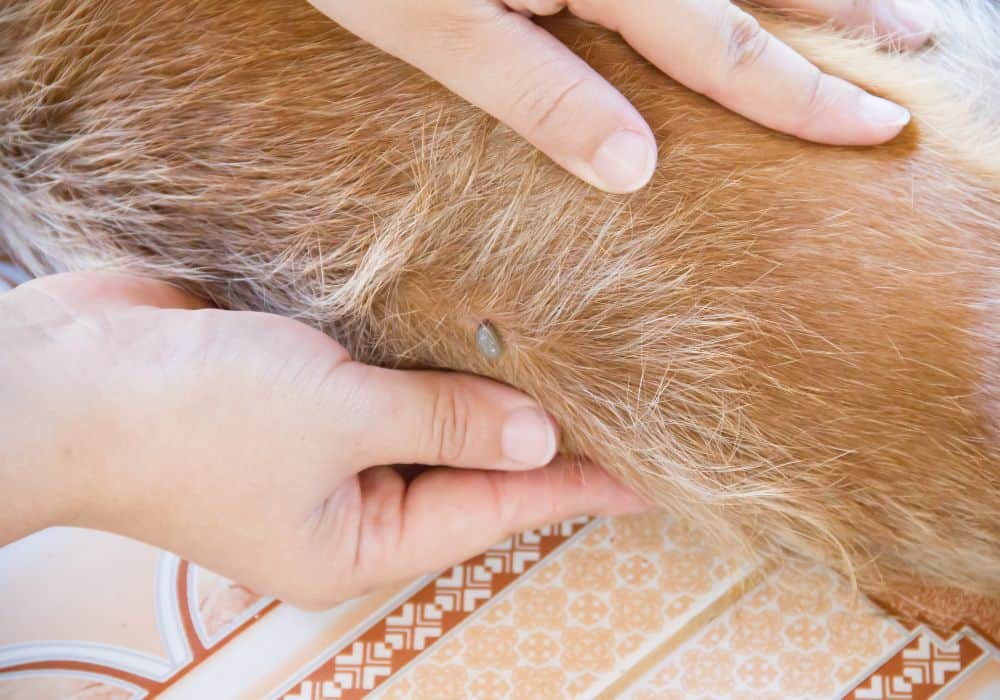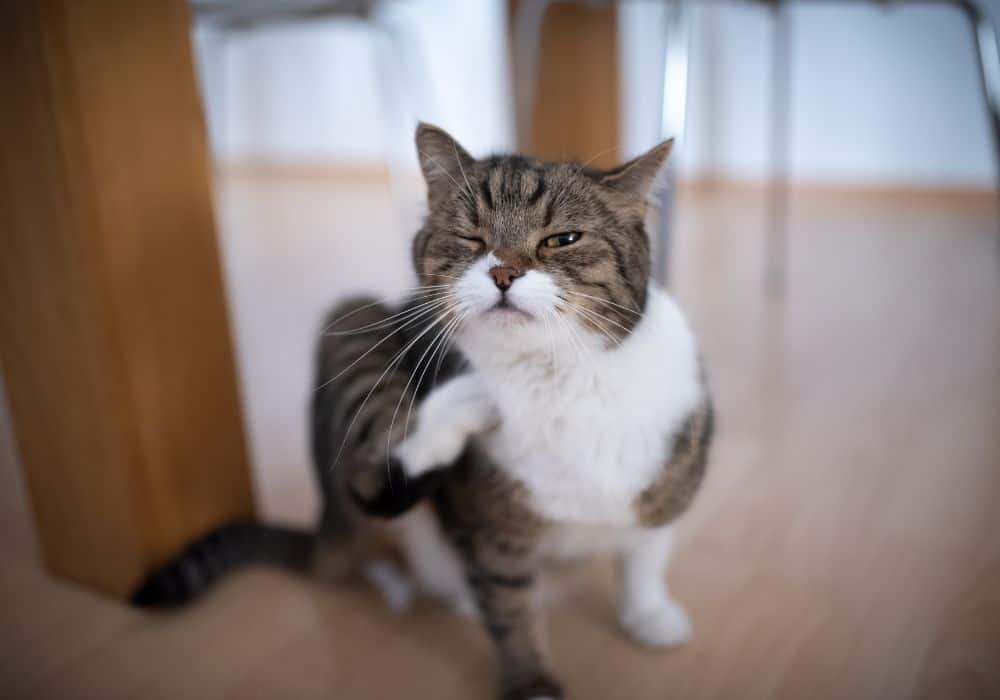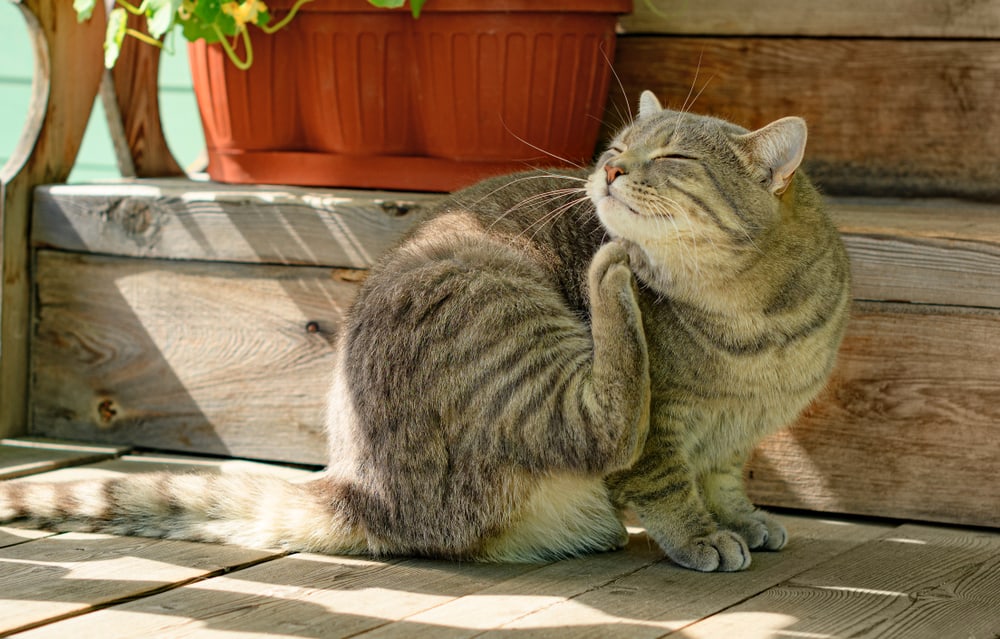There are some things every cat owner hopes to never ever have to encounter with their pet. Fleas certainly fall in this category. While they are not as directly impactful and dangerous as other parasites and health problems, fleas can cause a lot of other issues if left untreated. Even without those, however, fleas can be a huge annoyance for the whole household.
So, it’s quite normal for any cat owner to freak out the moment they see something untoward in their cat’s fur. If you notice actual living and moving fleas there, then identifying the issue isn’t a problem. What if you’re only seeing tiny white dots, however? Are those the dreaded flea eggs? Or are they just cat dandruff?
So, are you looking at cat dandruff or flea eggs? Below we’ll give you some pointers to help you figure out which are you dealing with and how to tell them apart.
Cat Dandruff or Flea eggs – How to Tell the Difference?
Flea eggs look like tiny white, oval-shaped, and partly translucent dots on your pet’s skin. Similarly, dandruff flakes appear like minuscule white specks under your pet’s fur. So, how can you tell the two apart?
Well, if you can take a proper look at the little things you can discern the differences directly – either with a naked eye or with a magnifying glass. The simplest difference is the shape – cat dandruff, just like human dandruff will have uneven shapes and varying sizes (usually still under 1 mm though) because it’s just dried skin flakes.
On the other hand, flea eggs will always be smooth and oval-shaped because they are eggs. So, if you’re seeing any uneven edges or strange shapes then you almost certainly aren’t dealing with parasites and you don’t need to worry about adult fleas jumping around.
Another difference between flea eggs and dandruff pieces is that the eggs of these insects tend to fall off the skin quite easily. This is pretty much as they are intended to be as the purpose of the eggs is to fall off the host and onto the ground or carpet where they can hatch into adult fleas.
If the white specks you see exhibit a kind of stickiness, however, and don’t fall off as easily, they are likely dandruff. Dandruff is just dry skin after all and easy shedding is not one of its intended purposes – it has no intended purposes.
Sometimes it’s difficult to just eyeball the situation, however. In those cases, you should look for side symptoms that might point you in the right direction. You’ll find out that looking for other symptoms of flea infestations, in particular, is the easier way to go. So, here are some signs of fleas you can watch out for:
- Grab a flea comb or another fine-toothed comb and start combing your pet’s hair. If there are any actual adult fleas in your pet’s hair, this will help you spot them.
- In addition to spotting adult fleas, combing through your cat’s hair will also help you find flea dirt. These dark red or black specks are technically the fleas’ feces. They have that color because your flea feasts on your cat’s blood.
- While combing through your pet’s fur you can also watch out for signs of flea bites on the skin. They appear quite similar to flea bites on human skin – tiny reddish bumps.
Just make sure that you don’t mistake a generally reddish coloring of the skin with a flea bite bump – some of the causes of excess dandruff such as seborrheic dermatitis can also cause reddish skin but there won’t be any bumps.
If you spot any of these signs, then the white specks you noticed earlier are almost certainly flea eggs and not just flea dandruff. If you’re finding neither flea dirt, bites, or the adult insects themselves, however, then your cat likely just has dandruff.
Why Spotting Flea Eggs is Important?

As with any flea infestation, it’s important to catch and address the problem as early as possible. In many cases, this is best done by catching the first set of eggs of these tiny creatures as once those hatch, the infestation becomes quite overblown.
To understand why that’s the case, let’s look at the standard flea life cycle. First, your pet will catch a couple of fleas from going outdoors or from your shoes once you get back home. Those first few initial fleas can be either male or female but it takes just one female flea to lay eggs in your pet’s fur for things to kick into high gear.
It takes just a couple of days for one female flea to lay her eggs into your cat’s fur and another few days (up to two weeks maximum) for them to fall on the floor and start hatching into flea larva. From there, the larva can take 5 to 14 days to turn into pupae (cocoon), and then – a week or more to transition into an adult flea.
Most of the last few stages of a flea’s lifetime will be difficult to notice as we can’t easily spot the presence of flea larva or pupae in the carpet. We can see the flea eggs in our pet’s fur, however, which is why it’s important not to ignore them when we do.
How to deal with flea eggs on your cat?
Dealing with flea eggs on your kitty before they’ve managed to hatch is crucial as after that the problem will become much harder to deal with. To do so, you can contact your veterinarian to recommend the right type of medication for your pet. There are various sprays and pet shampoos that can do the trick here.
We would recommend against cat shampoos, however, and your vet will likely say the same. While they can be effective against adult fleas and their eggs, and they do have the benefit of not having to get your cat wet, dry shampoos tend to leave residue on the cat fur that your pet will later lick off and that’s not exactly healthy.
A lot of cat owners dread bathing their feline pets but there are some good guides out there on how to do so safely and without stressing your animal out too much.
Once you’ve removed all the fleas and their eggs off your animal, the next step is to make sure that you get rid of any eggs that may have fallen on the floor. Make sure to vacuum your home properly, including the upholstery of all your furniture and any crack and crevice on the floor.
Cat Dandruff vs Cat Dander

Now that we know how to deal with the flea scenario, let’s look into what you should do if your cat has dandruff. First, however, let’s explain the difference between cat dander and dandruff because a lot of people use these two terms interchangeably and wrong.
Cat dander is the natural shedding of dead skin cells that any cat (and mammal, really) does. Dande isn’t indicative of anything problematic such as skin infections, allergies, dry skin, or other skin conditions. Furthermore, it’s also hard to spot because dander is usually quite miniature.
Dandruff, on the other hand, is larger pieces of flaky skin that are typically caused by a fungal infection such as the aforementioned seborrheic dermatitis. this condition can lead to a lot of scratching and discomfort but isn’t immediately dangerous to your cat’s health. It can be a symptom of an underlying problem, however, so it shouldn’t be ignored either.
How to deal with cat dandruff?
Simply put, the presence of dandruff on your cat’s skin indicates things such as poor diet, lack of grooming, too much stress in the animal’s life, or other underlying and internal medical problems. A vet visit is recommended but in most cases, pet owners have to just groom their cats better and add some omega-3 in their diet to ensure healthy skin.
In Conclusion
It’s perfectly normal to be confused about whether you’re looking at cat dandruff or flea eggs in your cat’s fur. Once you know the differences and what else to watch out for, however, telling the two apart shouldn’t be that much trouble.
Even using something as simple as a school kit’s magnifying glass should help you tell the difference between the angular shapes of cat dandruff and the smooth and oval flea eggs. If you’re still not certain, however, the best way to go about it is to just look for other signs of the presence of fleas in your pet’s fur. If what you’re looking at are actual flea eggs, there should also be the adult fleas themselves, as well as the dirt they leave behind.
